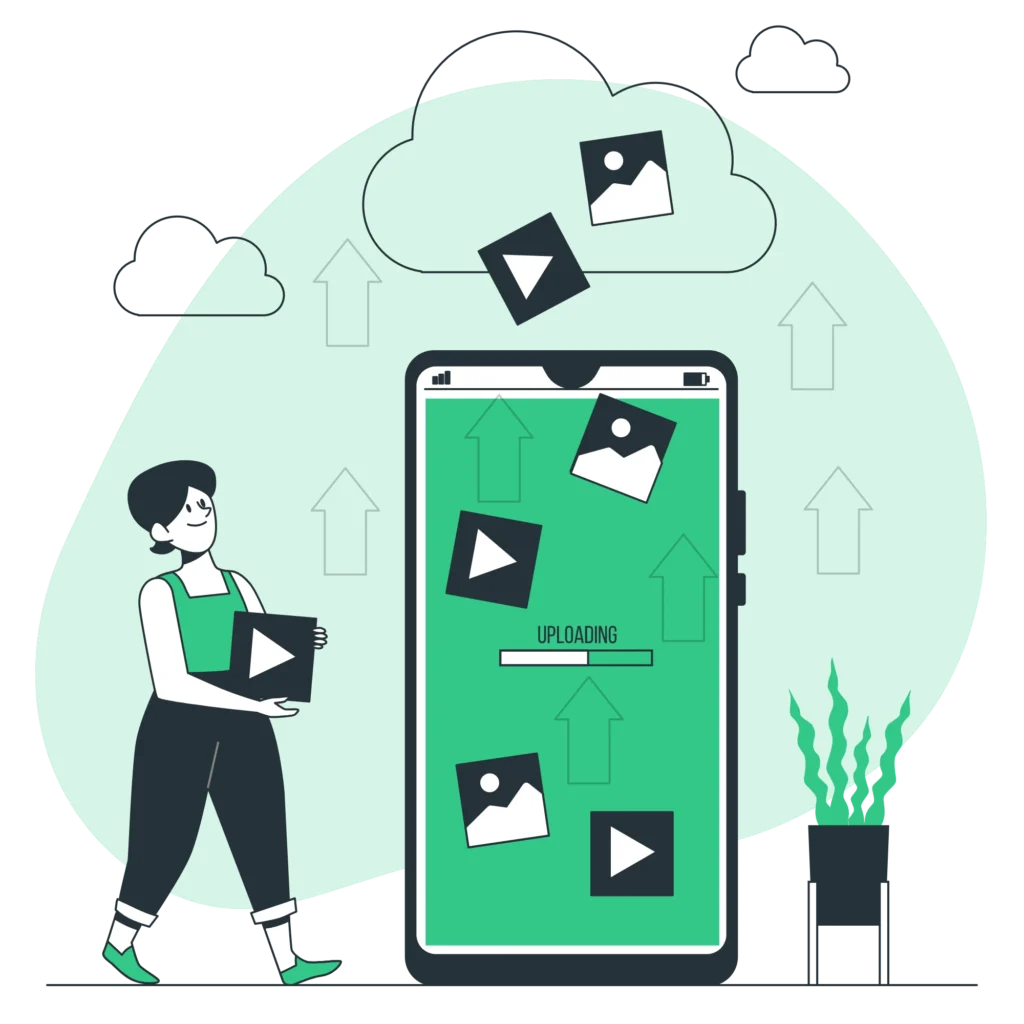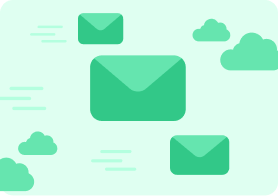Technical Interview Preparation
- Technical Interview Questions
- HTML Interview Questions
- CSS Interview Questions
- JavaScript Interview Questions
- React JS Interview Questions
- Node.js interview questions
- MERN Stack Interview Questions
- Data Analytics Interview Questions
- C++ Technical Interview Questions
- Python Interview Questions
- Java Interview Question
- Most Asked Coding Question
- DSA interview questions
- Computer Network Interview Question
- Cloud Computing Interview Question
- Other Related Links
Top 50 Cloud Computing Interview Questions
Top 50 Most Important Cloud Computing Interview Questions
Find the Most Asked Top 50 Cloud Computing Interview Questions and Answers on this page. Prepare for your interview with PrepInsta.
This page will cover some common Mostly asked Cloud Computing Interview Questions along with simple answers to help freshers get ready for their interviews. Whether you’re new to interviews or want to improve your skills, this guide will help you understand the basics and prepare you to tackle Cloud Computing questions with confidence.
Page Highlights:
- What is Cloud Computing ?
- Top 50 Cloud Computing Interview Questions with Answers
Most Asked Top 50 Cloud Computing Interview Questions
Ques 1: What is Cloud Computing?
Ans.
- Cloud computing is a model that enables on-demand access to a shared pool of configurable computing resources, such as servers, storage, applications, and services, over the internet.
- This model allows users and enterprises to store and process data in data centers maintained by third-party providers, reducing the need for local infrastructure.
- National Institute of Standards and Technology (NIST) defines cloud computing with five essential characteristics: on-demand self-service, broad network access, resource pooling, rapid elasticity, and measured service.
Ques 2: What are the different types of cloud deployment models?
Ans.
Cloud deployment models define the specific environment and configuration of a cloud infrastructure.
- Public Cloud: Services are delivered over the public internet and shared across multiple organizations. Examples include Amazon Web Services (AWS), Microsoft Azure, and Google Cloud Platform (GCP).
- Private Cloud: Exclusive cloud infrastructure operated solely for a single organization. It can be managed internally or by a third party and hosted either on-premises or off-site.
- Hybrid Cloud: A combination of public and private clouds, allowing data and applications to be shared between them. This model offers greater flexibility and optimization of existing infrastructure, security, and compliance.
- Community Cloud: A collaborative cloud infrastructure shared by several organizations with common concerns, such as security, compliance, or jurisdiction. It can be managed by the organizations or a third party.
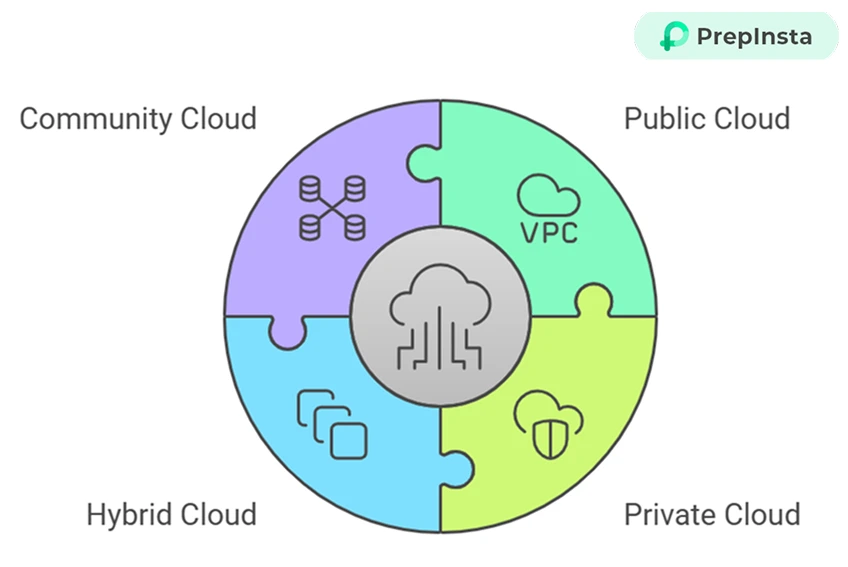
Ques 3: What are the main service models of cloud computing?
Answer:
- Infrastructure as a Service (IaaS):
Provides virtualized computing resources over the internet, including virtual machines, storage, and networks. Users have control over the operating systems and deployed applications. Examples: AWS EC2, Google Compute Engine. - Platform as a Service (PaaS):
Offers hardware and software tools over the internet, typically for application development. It abstracts the underlying infrastructure, allowing developers to focus on building applications. Examples: Heroku, Google App Engine. - Software as a Service (SaaS):
Delivers software applications over the internet on a subscription basis. Users access the software via web browsers, with the underlying infrastructure managed by the service provider. Examples: Salesforce, Microsoft Office 365.
Ques 4: What do you mean by serverless computing?
Answer:
- Serverless computing is a cloud execution model where the cloud provider dynamically manages the allocation and provisioning of servers.
- In this model, developers write code in the form of functions, which are executed in response to events. Term “serverless” implies that developers do not need to manage server infrastructure; instead, they focus solely on code.
- Billing is based on the actual execution time and resources consumed by the functions.
Examples of serverless platforms include AWS Lambda, Azure Functions, and Google Cloud Functions.
Ques 5: What is virtualization, and how does it relate to cloud computing?
Answer:
- Virtualization is the process of creating a virtual version of something, such as hardware platforms, storage devices, or network resources.
- In cloud computing, virtualization allows multiple virtual machines (VMs) to run on a single physical server, each with its own operating system and applications.
- This maximizes resource utilization and provides isolation between different users or applications.
- Virtualization is a foundational technology for cloud computing, enabling resource pooling, scalability, and efficient management of data centers.
Ques 6: What are the key benefits of cloud computing?
Answer:
Cloud computing offers several advantages:
- Cost Efficiency: Reduces or eliminates the need for capital expenditure on hardware and maintenance.
- Scalability: Allows resources to be scaled up or down based on demand, ensuring optimal performance.
- Accessibility: Enables access to applications and data from anywhere with an internet connection.
- Automatic Updates: Providers manage and deploy updates, ensuring users have access to the latest features and security patches.
- Disaster Recovery: Offers robust backup and recovery solutions, enhancing data resilience.
Ques 7: What is a hypervisor ?
Answer:
- Hypervisor, also known as a virtual machine monitor (VMM), is software that creates and manages virtual machines by abstracting the underlying hardware.
- It allows multiple operating systems to run concurrently on a single physical machine.
There are 2 main types of hypervisors:
- Type 1 (Bare-Metal): Runs directly on the host’s hardware without an underlying operating system. It’s efficient and commonly used in enterprise data centers. Examples: VMware ESXi, Microsoft Hyper-V, Xen.
- Type 2 (Hosted): Runs on top of a conventional operating system. It’s generally used for development, testing, or personal use.
Examples: VMware Workstation, Oracle VirtualBox.
Ques 8: What is the difference between scalability and elasticity?
| Scalability | Elasticity |
|
|
Ques 9: What are the security risks associated with cloud computing?
Answer:
Cloud computing introduces several security challenges:
- Data Breaches: Unauthorized access to sensitive data stored in the cloud.
- Data Loss: Accidental or malicious deletion of data without adequate backups.
- Account Hijacking: Attackers gaining control over user accounts through phishing or other means.
- Insecure APIs: Vulnerabilities in application programming interfaces that can be exploited.
- Denial of Service (DoS) Attacks: Overloading cloud services to make them unavailable to legitimate users.
- Insider Threats: Malicious actions by individuals within the organization.
Ques 10: What is multi-tenancy in cloud computing?
Answer:
- Multi-tenancy is an architecture where a single instance of a software application serves multiple customers (tenants).
- Each tenant’s data is isolated and remains invisible to others, but they share common infrastructure and resources.
- This model optimizes resource utilization and reduces costs, as maintenance and updates are centralized.
Top 50 Cloud Computing Interview Questions with Answers
Ques 11: What is cloud computing On demand functionality?
Answer:
- Cloud computing offers on-demand functionality through self-service portals where users can provision resources like computing power, storage, and applications as needed, without human intervention from the service provider.
- This is facilitated by virtualization and automation technologies, enabling rapid deployment and scaling of resources.
Ques 12: Tell us about the Role of APIs in cloud services?
Answer:
Application Programming Interfaces (APIs) are integral to cloud services as they define the protocols and tools for building and interacting with software applications.
In cloud computing, APIs enable:
- Service Integration: Allowing different cloud services to communicate and work together.
- Automation: Facilitating the automated management of cloud resources.
- Customization: Enabling users to tailor services to their specific needs.
APIs provide a standardized way for developers to interact with cloud services, enhancing flexibility and efficiency.
Ques 13: What is the difference between public, private, and hybrid clouds?
| Public Cloud | Private Cloud | Hybrid Cloud |
|
|
|
Ques 14: What is edge computing, and how does it relate to cloud computing?
Answer:
- Edge computing involves processing data closer to its source, such as IoT devices, rather than in a centralized cloud data center.
- This approach reduces latency, conserves bandwidth, and enhances real-time data processing.
- While cloud computing centralizes resources, edge computing decentralizes them, and together they can provide a more efficient and responsive computing environment.
Ques 15: What are the economic benefits of cloud computing?
Answer:
Cloud computing offers several economic advantages:
- Reduced Capital Expenditure: Eliminates the need for significant upfront investments in hardware and infrastructure.
- Operational Efficiency: Allows businesses to pay only for the resources they use, reducing operational costs.
- Scalability: Enables businesses to scale resources up or down based on demand, optimizing costs.
- Maintenance Savings: Service providers handle maintenance and upgrades, reducing the need for in-house IT personnel.
Ques 16: What is a cloud service level agreement (SLA)?
Answer:
- Service Level Agreement (SLA) is a contract between a cloud service provider and a customer that specifies the expected level of service.
- It outlines metrics such as uptime guarantees, performance benchmarks, support response times, and remedies or penalties for service breaches.
- SLAs are crucial for setting clear expectations and ensuring accountability.
Ques 17: How we can ensure data security in the cloud?
Answer:
- Data Encryption: Encrypting data both at rest and in transit to prevent unauthorized access.
- Access Controls: Implementing strict identity and access management policies.
- Regular Audits: Conducting security assessments and compliance audits.
- Backup and Recovery: Establishing robust backup and disaster recovery plans.
- Monitoring: Continuous monitoring of systems for suspicious activities.
Ques 18: What is containerization ?
Answer:
Containerization is a lightweight form of virtualization that involves encapsulating an application and its dependencies into a container, ensuring consistency across various environments.
Ques 19: What is the difference between vertical and horizontal scaling in cloud computing?
Answer:
| Vertical Scaling | Horizontal Scaling |
Involves adding more power to an existing machine, such as increasing CPU, RAM, or storage. This is similar to upgrading a server to handle increased load. While it can enhance performance, there’s a limit to how much a single machine can be upgraded. | Includes adding more machines or instances to a system, distributing the load across multiple servers. This approach offers greater flexibility and can handle larger increases in demand by simply adding more nodes to the system. |
Ques 20: What is a Virtual Private Cloud ?
Answer:
Virtual Private Cloud (VPC) is a private cloud environment hosted within a public cloud. It provides a logically isolated section of the provider’s cloud where users can launch resources in a virtual network defined by them.
Top 50 Cloud Computing Interview Questions
Ques 21: What is the Shared Responsibility Model in cloud computing?
Answer:
- Cloud Provider’s Responsibilities: Security “of” the cloud, including the physical infrastructure, hardware, software, networking, and facilities that run cloud services.
- Customer’s Responsibilities: Security “in” the cloud, encompassing data protection, identity and access management, application security, and configuring security settings within the cloud services.
Ques 22: What are the different data storage types in cloud computing?
Answer:
- Object Storage: Manages data as objects, suitable for storing large amounts of unstructured data like media files.
Examples include Amazon S3 and Azure Blob Storage. - Block Storage: Provides raw storage volumes that can be attached to virtual machines, similar to traditional disk drives. Ideal for databases and applications requiring low-latency access.
Examples are Amazon EBS and Google Persistent Disks. - File Storage: Offers a shared file system that multiple virtual machines can access simultaneously. Suitable for applications that rely on shared file systems.
Examples include Amazon EFS and Azure Files.
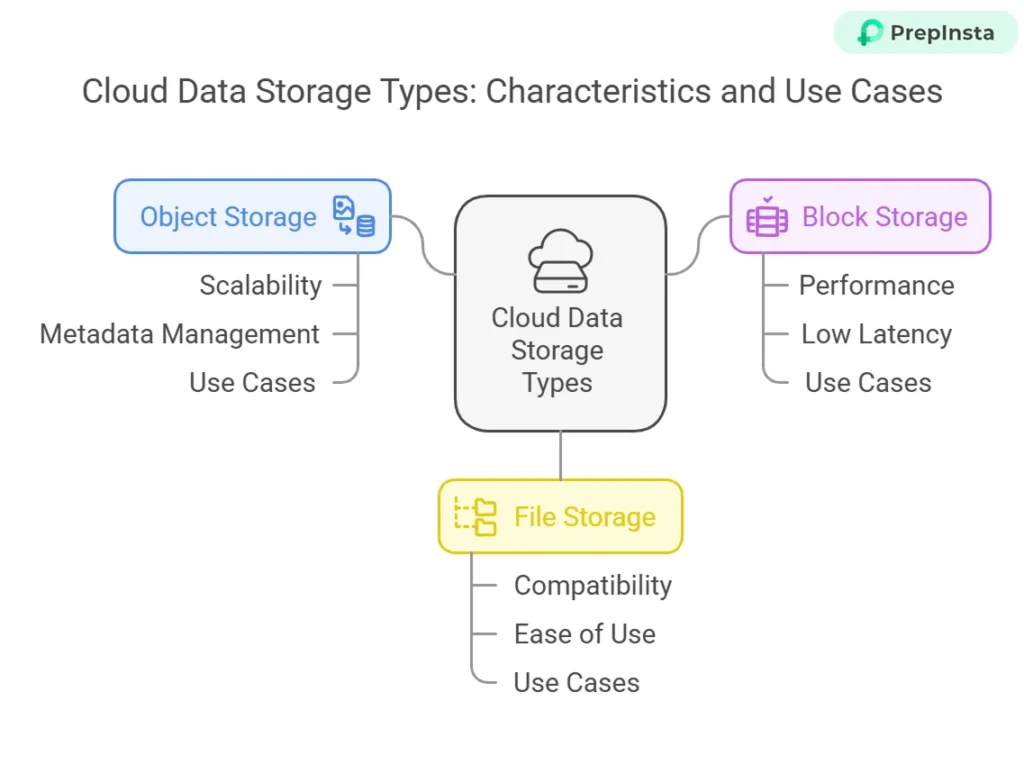
Ques 23: What is Cloud Bursting?
Answer:
Cloud bursting is a hybrid cloud strategy where an application primarily runs in a private cloud or data center and “bursts” into a public cloud when the demand for computing capacity spikes.
This approach ensures that applications have access to additional resources during peak times without the need for over provisioning in the private cloud, optimizing cost and resource utilization.
Ques 24: How do you monitor and manage cloud resources?
Answer:
Monitoring and management of cloud resources involve:
- Monitoring Tools: Utilizing cloud-native or third-party tools to track performance metrics, resource utilization, and application health.
Examples include Amazon CloudWatch, Azure Monitor, and Google Stackdriver. - Automation: Implementing automated scaling, backups, and patch management to maintain optimal performance and security.
- Logging: Collecting and analyzing logs to detect anomalies, troubleshoot issues, and ensure compliance.
- Alerts: Setting up alerts to notify administrators of potential issues or threshold breaches.
Ques 25: What is the significance of latency and bandwidth in cloud computing?
Answer:
- Latency: The time it takes for data to travel from the source to the destination. Low latency is crucial for applications requiring real-time interactions, such as video conferencing or online gaming.
- Bandwidth: The maximum rate at which data can be transferred over a network. Higher bandwidth allows more data to be transmitted, which is essential for data-intensive applications.
Top 5 Cloud Service Providers
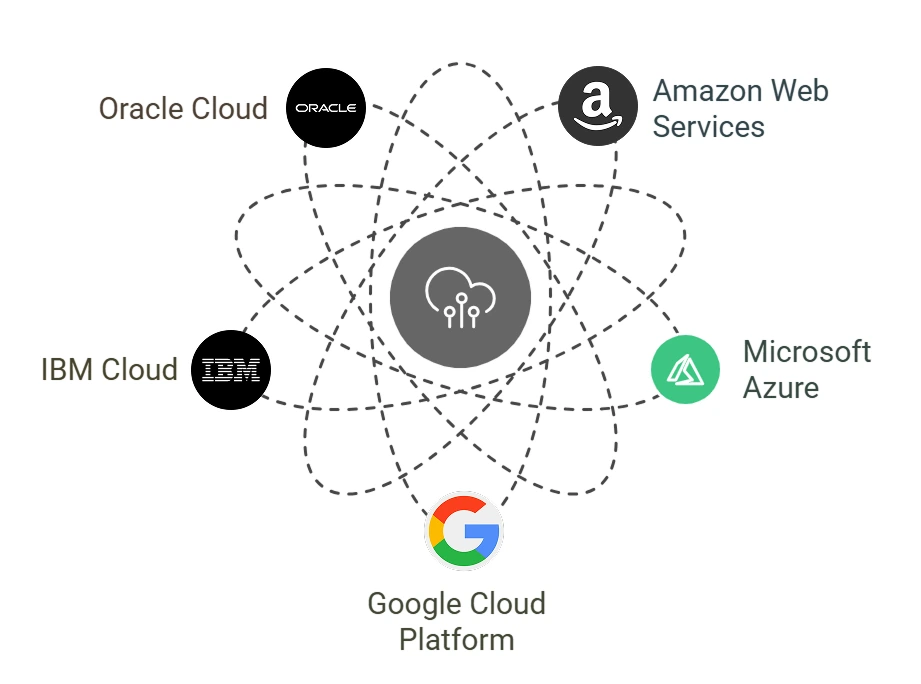
Ques 26: What are the factors affecting migration of applications to cloud?
Answer:
Migrating applications to the cloud requires careful planning:
- Assessment: Evaluating the existing application architecture, dependencies, and performance requirements.
- Cost Analysis: Estimating the costs associated with cloud resources, including potential savings and expenses.
- Security: Ensuring data protection, compliance with regulations, and implementing necessary security measures.
- Compatibility: Verifying that the application is compatible with the target cloud environment.
- Testing: Conducting thorough testing in the cloud environment to identify and resolve issues before full-scale migration.
Ques 27: What is Infrastructure as Code (IaC)?
Answer:
Infrastructure as Code (IaC) is a practice where infrastructure provisioning and management are performed using code and automation, rather than manual processes.
This approach allows for:
- Consistency: Ensuring that environments are configured identically, reducing discrepancies.
- Version Control: Tracking changes to infrastructure configurations through version control systems.
- Automation: Deploying and managing infrastructure efficiently using scripts and templates.
Ques 28: What are Cloud Access Control Models?
Answer:
Cloud access control models define how users and services access resources.
Common models include:
1. Mandatory Access Control (MAC):
Strictest model where access is controlled by a central authority.
Used in government and military systems.
2. Discretionary Access Control (DAC):
Users have control over resource permissions.
Example: File owner deciding who can read or edit a file.
3. Role-Based Access Control (RBAC):
Access is granted based on user roles within an organization.
Example: Admins have full control, while employees have limited access.
Attribute Based Access Control (ABAC):
Access is based on attributes such as time, location, and device.
Example: user can access a system only during office hours.
Ques 29: What are Cloud Monitoring and Cloud Logging?
Answer:
1. Cloud Monitoring: Tracks performance metrics like CPU usage, memory, latency, and uptime.
Example: Amazon CloudWatch, Azure Monitor.
2. Cloud Logging: Captures logs of system activities and events for analysis.
Example: Google Cloud Logging, AWS CloudTrail.
Ques 30: What is Auto Scaling in Cloud Computing?
Answer:
Auto-scaling dynamically adjusts the number of cloud resources based on demand.
Types of Auto-Scaling:
- Horizontal Scaling: Adds or removes instances.
- Vertical Scaling: Increases or decreases the capacity of an existing instance.
Examples:
- AWS Auto Scaling
- Azure Scale Sets
- Google Cloud Autoscaler
Cloud Computing Interview Questions
Ques 31: What is Identity and Access Management (IAM) in Cloud Computing?
Answer:
IAM is a framework that manages user identities and access permissions.
Features:
- User authentication and authorization.
- Role-based access control (RBAC).
- Multi-factor authentication (MFA).
- Audit logs for compliance.
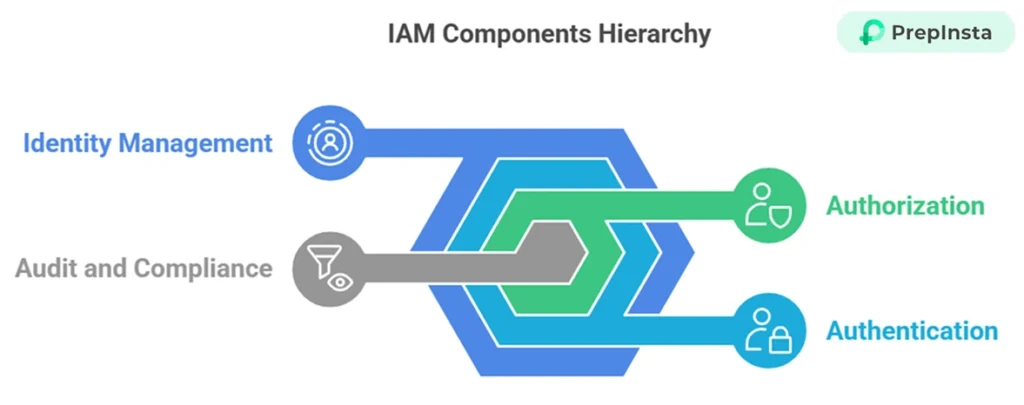
Ques 32: What is a Content Delivery Network ?
Answer:
- CDN is a distributed network of servers that delivers content to users based on their location.
- Stores cached copies of web content in multiple locations.
- Reduces latency by serving content from the nearest server.
Ques 33: What are the Key Components of Cloud Computing?
Answer:
- Compute: Virtual machines, containers.
- Storage: Object, block, and file storage.
- Networking: Virtual networks, VPNs, firewalls.
- Security: IAM, encryption, compliance.
- Management & Monitoring: Auto-scaling, logging, analytics.
Ques 34: What is Cloud Orchestration?
Answer:
- Cloud orchestration is the process of automating and managing cloud resources, services, and workloads across different cloud environments.
- It helps streamline cloud operations by coordinating multiple automated tasks to ensure efficient resource provisioning, configuration, and deployment.
Ques 35: Difference Between Cloud Orchestration and Cloud Automation ?
Answer:
| Feature | Cloud Orchestration | Cloud Automation |
| Definition | Coordination of multiple automated tasks to streamline workflows. | Execution of individual automated tasks (e.g., starting a virtual machine). |
| Scope | End to end process automation. | Task level automation. |
| Example | Deploying a full stack application (database, web server, load balancer). | Automatically restarting a failed instance. |
Ques 36: What is EUCALYPTUS in cloud computing? Why is it used?
Answer:
- Eucalyptus (Elastic Utility Computing Architecture for Linking Your Programs to Useful Systems) is an open-source cloud computing platform that enables organizations to create private and hybrid clouds.
- It is designed to be compatible with Amazon Web Services (AWS), which makes it easier for businesses to migrate between their private cloud and AWS.
Ques 37: Explain System Integrators in Cloud Computing.
Answer:
- System integrators are companies or professionals who specialize in connecting different cloud-based systems, services, or applications to work together as a cohesive solution.
- They integrate a company’s existing IT infrastructure with cloud platforms and ensure smooth communication and operation across various cloud services and on-premise systems.
Ques 38: How can you integrate CI/CD pipelines with cloud platforms?
Answer:
Integrating CI/CD (Continuous Integration/Continuous Deployment) pipelines with cloud platforms allows for the automation of software development processes, improving efficiency and reducing errors.
Step 1: Choose CI/CD Tools:
Tools like Jenkins, GitLab CI, CircleCI, or Travis CI are popular for creating CI/CD pipelines.
Step 2: Cloud Provider Setup:
Choose a cloud provider like AWS, Azure, or Google Cloud. Each of these platforms offers services for integrating with CI/CD tools.
- AWS: You can use AWS CodePipeline, AWS CodeDeploy, and AWS CodeBuild for automating build, test, and deployment pipelines.
- Azure: Use Azure DevOps and Azure Pipelines for continuous integration and delivery.
- Google Cloud: Google Cloud Build integrates with GitHub, GitLab, etc., for automated CI/CD workflows.
Step 3: Automate Deployment:
Once your CI/CD pipeline is set up, you can automate:
- Code Integration: Automatically pull code from version control systems (e.g., GitHub, GitLab) and build it.
- Automated Testing: Run unit and integration tests to ensure quality.
- Deployment: Once tests pass, automatically deploy the application to the cloud platform.
Step 4: Monitor and Scale:
After deployment, monitor the application using cloud monitoring tools like AWS CloudWatch or Azure Monitor and use the cloud’s scalability features to scale the application based on traffic.
Ques 39: Describe the Cloud Computing Architecture.
Answer:
1. Front-End (Client Side):
- User Interface: The front-end is the part of the cloud service the user interacts with, such as web browsers or mobile applications.
- Client Applications: These allow users to access the cloud services (e.g., a web browser to access a SaaS application).
2. Back-End (Server Side):
- Cloud Infrastructure: Includes all the physical resources like data centers, servers, networking, and storage devices.
- Virtualization: It creates virtual machines (VMs) and manages resources dynamically.
3. Cloud Service Models:
The back end provides the three main service models:
- IaaS (Infrastructure as a Service): Offers virtualized computing resources over the internet (e.g., AWS EC2, Azure VMs).
- PaaS (Platform as a Service): Provides a platform for developers to build applications without managing infrastructure (e.g., Google App Engine, Azure App Services).
- SaaS (Software as a Service): Cloud applications like email, CRM, etc., that are accessed via the internet (e.g., Gmail, Salesforce).
4. Cloud Services:
- Compute, Storage, Networking: The backbone that powers the cloud services provided to the users.
- Data Management: Ensures that data is securely stored, retrieved, and managed across various services.
Ques 40: What is Resource Pooling Architecture in Cloud Computing?
Answer:
Resource Pooling is a key concept in cloud computing where the cloud provider pools computing resources (e.g., storage, CPU, memory) to serve multiple customers, using multi-tenant models. The provider’s resources are shared, but each customer’s data is kept isolated.
Example:
- In a cloud environment, a provider may have thousands of virtual machines (VMs) in a data center.
- These VMs are pooled together and allocated to customers based on their usage, such as when a company needs more computing power for a short period, the cloud can instantly provide more resources.
Top 50 Cloud Computing Interview Questions
Ques 41: What are low density data centers?
Answer:
- Low-density data centers are data centers where each rack of servers has fewer physical machines than usual.
- This setup is done to prevent overheating, improve performance, and enhance energy efficiency.
Ques 42: How does hypervisor security work in cloud computing?
Answer:
- Hypervisor is a software that allows multiple virtual machines (VMs) to run on a single physical server.
- Hypervisor security refers to protecting the hypervisor from attacks or unauthorized access.
Ques 43: What is a cloud usage monitor?
Answer:
A cloud usage monitor is a tool that tracks and reports how cloud resources (like computing power, storage, and network bandwidth) are being used.
Ques 44: What are Containerized Data Centers?
Answer:
A containerized data center is a portable data center housed in a shipping container or modular unit. It contains servers, storage, networking equipment, and cooling systems.
Ques 45: What does encapsulation mean in cloud computing?
Answer:
- Encapsulation in cloud computing means hiding the details of an application’s processes and allowing users to access only necessary parts.
- It ensures that users interact with cloud services without needing to understand how they work internally.
Ques 46: What does rate limiting mean in cloud computing?
Answer:
Rate limiting controls how many requests a user or system can make to a cloud service within a specific time. It prevents system overload and protects against cyberattacks.
Ques 47: Why are microservices important?
Answer:
Microservices allow applications to be built as small, independent services that work together.
They are important for cloud-based applications because they offer:
- Scalability: Each service can be scaled independently.
- Fault Tolerance: If one service fails, others continue running.
- Faster Deployment: Updates can be made without affecting the entire application.
Ques 48: What do you mean by microservices in cloud computing?
Answer:
Microservices are a way of building applications as a collection of small, loosely connected services instead of one big program. Each service has its own function and communicates with others through APIs.
Ques 49: What is CaaS?
Answer:
CaaS (Containers as a Service) is a cloud service that provides container management and deployment tools to developers. It helps run applications in containers without managing the underlying infrastructure.
Ques 50: How Does Data Replication Work in the Cloud?
Answer:
- Data replication in cloud computing is the process of copying and storing data across multiple locations to ensure high availability, reliability, and disaster recovery.
- It helps in data protection, load balancing, and performance improvement by distributing data across different servers or regions.
Types of Data Replication in Cloud Computing:
- Synchronous Replication
- Asynchronous Replication
- Multi Region Replication
- Storage Level Replication
Also Check:
- C++ Technical Interview Questions
- OS Technical Interview Questions
- C Technical Interview Questions
- JAVA Technical Interview Questions
- Python Technical Interview Questions
- DSA Technical Interview Questions
- DBMS Technical Interview Questions
- Software Engineering Question
- DSA Technical Interview Questions For Freshers
- Github Technical Interview Questions
- SQL Technical Interview Questions
- Most Asked Coding Question

 Apply For Jobs
Apply For Jobs Get Hiring Updates
Get Hiring Updates